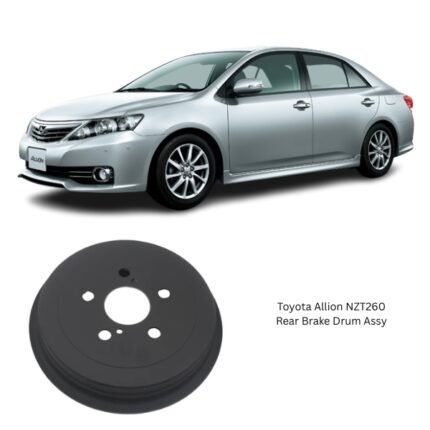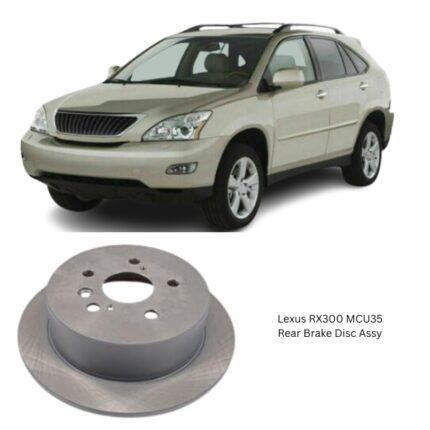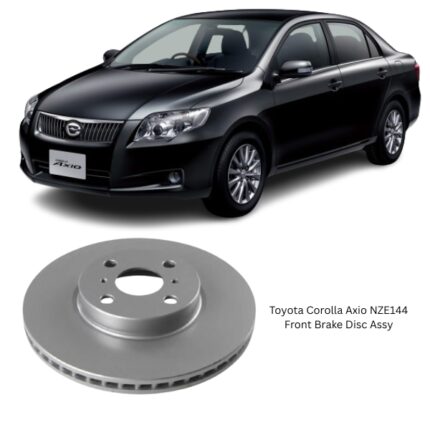Get Toyota Corolla Axio NZE144 Front Brake Disc Assy 43512-52130 in Kenya
The Front Brake Disc Assembly is a critical component of a vehicle’s disc brake system, responsible for converting kinetic energy into heat through friction, ultimately slowing or stopping forward motion. Positioned at the front axle and mounted directly to the wheel hub, the disc—also commonly referred to as a rotor—works in conjunction with the brake caliper and brake pads to deliver reliable, consistent braking force.
Disc brakes are a foundational element in modern braking systems, particularly in the front axle due to the dynamic weight transfer that occurs during deceleration. The front brake disc is exposed to intense friction and high temperatures during operation, making it essential for the component to exhibit superior strength, thermal stability, and precision balance.
Functional Overview
The core function of the front brake disc is to provide a rotating friction surface for the brake pads to clamp against during braking. When the driver presses the brake pedal, hydraulic fluid activates the brake caliper pistons, causing the brake pads to squeeze against the rotating disc. This contact slows the wheel’s rotation through friction, dissipating kinetic energy as heat.
The front disc operates in a high-stress environment—experiencing rapid temperature increases, rotational forces, and pressure loads with every braking cycle. Proper performance of the front brake disc is vital for safe, stable stopping power and is integral to vehicle control during emergency stops or downhill descents.
Key Components of a Front Brake Disc Assembly
A complete front brake disc assembly typically includes:
-
Brake Disc (Rotor)
The central rotating component made of cast iron or composite alloys. It is mounted to the wheel hub and rotates with the wheel. Brake pads clamp onto the disc’s surface to create friction. -
Hub Mounting Surface
The inner section of the disc that interfaces with the wheel hub. It includes bolt holes or a central bore for secure mounting, ensuring concentric alignment with the axle. -
Cooling Vanes (for Ventilated Rotors)
Found between the disc’s inner and outer friction surfaces, these vanes facilitate airflow through the rotor to dissipate heat and prevent brake fade. -
Friction Surface
The area where the brake pads make contact. Must be precisely machined, balanced, and finished to maintain uniform braking pressure and avoid vibration.
Depending on design, the brake disc can be either solid or ventilated. Ventilated rotors have internal channels to enhance cooling efficiency and are commonly used on the front axle due to higher braking loads.
Material Construction
Brake discs are predominantly constructed from gray cast iron due to its excellent thermal conductivity, wear resistance, and vibration damping properties. Some discs incorporate high-carbon formulations, offering enhanced heat resistance and reduced risk of thermal cracking or warping.
Other specialized materials include:
-
Carbon-ceramic composites (in high-performance applications): extremely light and heat-resistant.
-
Alloy steel with anti-corrosion coatings: for longevity in humid or salted road environments.
The friction surface is usually machined to a smooth finish and may include grooves or slots to improve debris evacuation and water dispersal, or cross-drilled holes for performance cooling and gas venting.
Performance and Heat Management
A properly designed front brake disc must handle intense thermal loads without compromising structural integrity. During braking, discs can reach temperatures in excess of 500°C (932°F). Key performance features include:
-
High thermal mass: Absorbs and disperses heat efficiently.
-
Vented vanes: Enhance airflow and cooling.
-
Balanced construction: Prevents vibration and ensures smooth rotation.
-
Low rotor runout: Maintains even contact with brake pads, reducing pedal pulsation.
If not adequately cooled, brake discs may suffer from heat spots, warping, or brake fade—all of which compromise safety and performance.
Installation and Fitment Considerations
During installation, several key factors ensure correct operation:
-
Rotor runout must be within manufacturer specifications to avoid uneven pad wear or steering wheel vibration.
-
Hub surface preparation is critical—debris or rust between the disc and hub can cause misalignment.
-
Torqueing of wheel bolts must be done in a crisscross pattern using a calibrated torque wrench to prevent warping.
Most front discs are non-directional, but certain vented or slotted discs have a specific rotational direction indicated on the rotor face for optimized cooling and performance.
Common Wear Patterns and Symptoms
Over time, brake discs experience natural wear. Typical wear indicators and problems include:
-
Scoring or grooves: Often caused by debris or worn-out pads.
-
Blue spots or discoloration: Evidence of overheating or poor pad contact.
-
Cracks: Often thermal in origin, typically from aggressive or high-speed braking.
-
Thickness variation: Known as disc thickness variation (DTV), leading to pedal pulsation and uneven braking.
Discs should be measured with a micrometer during service to ensure they have not worn below the minimum thickness specification, usually stamped on the rotor itself. Below-minimum thickness reduces heat capacity and compromises strength.
Service and Maintenance
Regular maintenance and inspection of the front brake disc assembly help maintain optimal braking performance:
-
Visual inspection: Look for surface cracks, rust, and excessive scoring.
-
Thickness measurement: Check against service limits.
-
Lateral runout test: Ensures the disc spins true on the hub.
-
Cleaning: Use brake cleaner to remove grease and contaminants from the rotor surface.
If resurfacing (machining) is necessary, it must be done within allowable limits. If the disc is below minimum thickness or severely damaged, replacement is the only option to restore safe operation.
Brake pads should also be replaced in pairs along with or shortly after replacing discs to ensure even wear and braking balance.
Advantages of Front Brake Discs Over Other Braking Systems
Disc brakes offer several inherent advantages that make them particularly effective for front axle braking:
-
Superior heat dissipation: Minimizes fade during repeated or prolonged braking.
-
Faster response time: Pads apply directly to the disc surface.
-
Self-cleaning: Open design resists accumulation of water, mud, or debris.
-
Easier inspection and maintenance: Friction surfaces and wear indicators are visible without disassembly.
-
Better modulation: Smoother pedal feel and control, especially under heavy braking.
These advantages make disc brakes a preferred choice for front applications where braking load is greatest.
Follow us on Facebook for more parts.





Reviews
Clear filtersThere are no reviews yet.